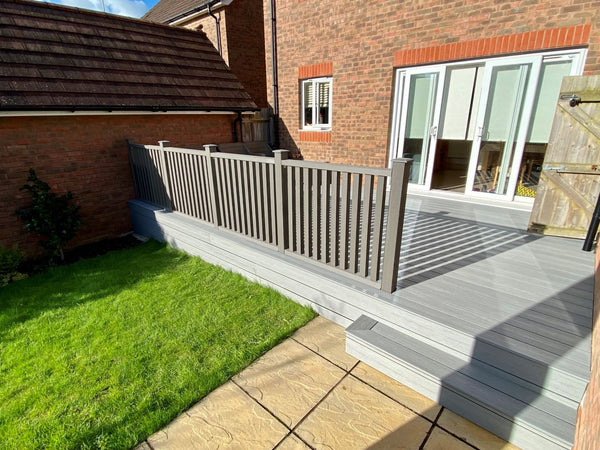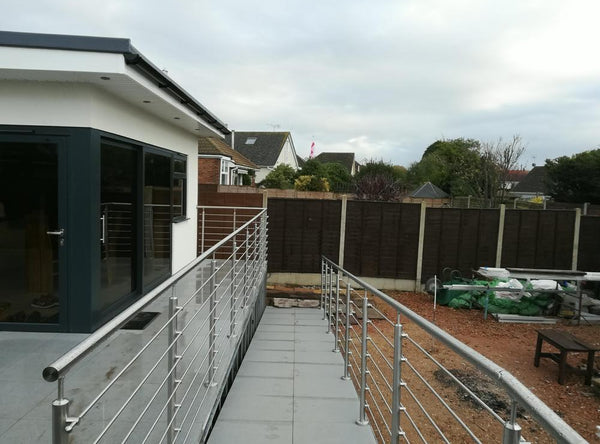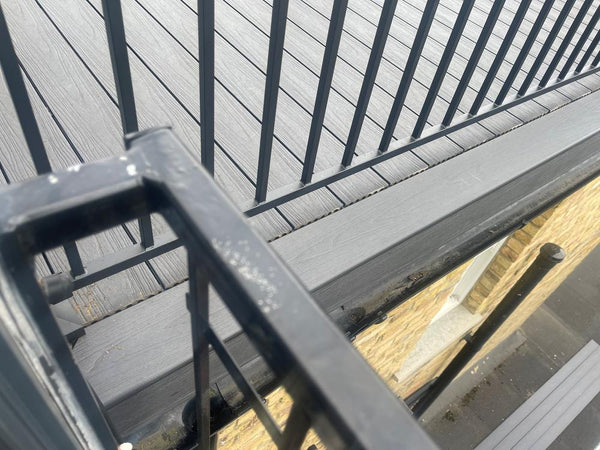Replacing banister spindles on outdoor staircases not only enhances the safety and functionality of your outdoor spaces but also significantly boosts their aesthetic appeal.
In this comprehensive guide, we delve into the essential tools and materials needed for the job, provide a detailed, step-by-step walkthrough on replacing a banister spindle, and explore the various components of stair railings.
Whether you're looking to undertake a minor update or a complete overhaul of your outdoor banisters, our insights and tips, grounded in years of expertise in decking and outdoor accessories, will ensure a smooth and successful transformation.
What this article covers:- Required Tools & Materials
- How to Replace a Banister Spindle
- What Are the Different Parts of a Stair Railing?
- What Parts of a Banister Can You Replace?
- Replacing Banister Spindles (FAQs)
Required Tools & Materials
Before we embark on this DIY adventure, let's ensure we have all the necessary tools and materials. You'll need:
- New spindles
- A saw
- Sandpaper or an electric sander
- A measuring tape
- A pencil for marking
- Adhesive
- A hammer and possibly a chisel
- Safety goggles
How to Replace a Banister Spindle
Step 1: Remove The Old Spindle
Removing the old spindle is the initial step in refreshing your outdoor banister. After replacing our fair share of spindles, we've found that this process can vary depending on the spindle's condition and how it's fixed into the banister.
For spindles that are nailed or screwed in, you might need to carefully pry them out with the help of a pry bar or pliers, taking care not to exert too much force that could damage the banister or the handrail.
For spindles that are glued, applying a bit of heat with a heat gun can loosen the adhesive, making it easier to remove the spindle. It's crucial to protect the integrity of the handrail and the base rail during this process, so using a block of wood as a buffer when applying force can help prevent any unwanted damage.
Step 2: Measure
Once the old spindle is out, accurate measurement becomes crucial to ensure the new spindle fits perfectly. Measure the distance between the base rail and the handrail to determine the banister height and length of the new spindle.
It's also a good idea to check that your baluster and spindle meet UK building requirements as outlined by Document K at this stage.
It's important to consider any angles or unique design features of your outdoor banister, as these can affect the spindle's length. Mark the required length on the new spindle, ensuring the markings are clear and precise. A mitre saw is ideal for making the cut, offering precision and a clean finish.
However, any sturdy saw that you're comfortable using can do the job. The key is to measure carefully and cut once, ensuring the new spindle will fit seamlessly into the space left by the old one.
Step 3: Fit And Secure
In our experience, fitting the new spindle requires attention to detail to ensure it aligns perfectly with the existing banister structure. Start by positioning the top of the spindle into the hole beneath the handrail, initially at a slight angle.
Carefully tap the spindle into a vertical position, ensuring it fits snugly without forcing it too much, which could damage the spindle or the railing. Once in position, secure the spindle at both the top and bottom.

For outdoor banisters, using adhesive is crucial to withstand the elements. This step not only ensures the spindle is firmly in place but also contributes to the overall stability and safety of the banister.
After the adhesive dries, your banister should look refreshed and more secure, with the new spindle blending seamlessly with the existing structure.
What Are the Different Parts of a Stair Railing?
Understanding the anatomy of your outdoor handrail is crucial, particularly when considering updates or repairs for outdoor staircases. Each component plays a vital role in the structure's functionality and aesthetic, regardless of the types of banisters.
Spindles/Balusters
Spindles, or balusters, are the vertical posts that span the length of the stair railing, providing critical support and safety by preventing falls. In outdoor settings, these elements are not only functional but also contribute to the overall design, often bearing the brunt of weather conditions.
Choosing durable materials resistant to moisture, temperature changes, and wear is essential for longevity and maintaining the staircase's integrity.
Banister/Handrail
What is a banister on stairs? The banister, or handrail, is the component you grasp as you ascend or descend the staircase. Positioned along the top of the spindles, it offers stability and support.

For outdoor staircases, the handrail must withstand various weather conditions, making materials like treated wood, metal, or composite ideal for their durability and ease of maintenance. The design and finish of the handrail can significantly influence the staircase's overall aesthetic appeal.
Base Rail
The base rail runs horizontally along the bottom of the spindles, anchoring them in place and contributing to the staircase's structural stability. In outdoor environments, the base rail is exposed to moisture and debris, necessitating materials that resist rot and corrosion.
Proper installation and sealing are crucial to prevent water accumulation and ensure the longevity of the entire railing system.
Newel Posts
Newel posts are the robust vertical pillars that anchor the stair railing at critical points, including the bottom, top, and any turns in the staircase. These posts bear much of the railing's weight and stress, especially in outdoor settings where wind and weather exert additional forces.
Selecting sturdy materials and ensuring secure installation is paramount to the safety and durability of the stair railing, with designs ranging from simple and functional to ornate and decorative, depending on the desired aesthetic.
What Parts of a Banister Can You Replace?
Every part can be changed when replacing a banister, especially in outdoor settings where elements like weather and wear take their toll.
From the spindles that add detail and safety to the handrail that provides support, the base rail that anchors the spindles, and the newel posts that serve as the main structural support, each component can be individually updated or entirely overhauled.
This flexibility allows for targeted repairs or a complete transformation of your outdoor staircase, ensuring it not only meets safety standards but also aligns with your aesthetic preferences and withstands environmental challenges.

When considering replacements, it's essential to choose materials and designs suited for outdoor exposure to ensure longevity and durability.
Conclusion
Replacing banister spindles, especially for outdoor staircases, is a practical and aesthetic upgrade that can significantly enhance the look and safety of your outdoor spaces.
From carefully removing the old spindle without damaging the surrounding area, accurately measuring and cutting the new spindle, to fitting and securely attaching it in place, each step is crucial for a successful installation.
With the right tools, materials, and a bit of patience, this DIY project is within reach for most homeowners.
For those looking to embark on this rewarding project, Ovaeda offers a wide range of high-quality outdoor decking and accessories to ensure your banister not only looks fantastic but stands the test of time. Explore our collection today and take the first step towards transforming your outdoor staircase.
Replacing Banister Spindles (FAQs)
Can I replace a banister myself?
Absolutely! With some basic DIY skills and the right tools, replacing a banister or its components is a manageable project.
How often should spindles be replaced?
There's no set timeframe for replacing spindles. It's more about aesthetics and safety. If they're damaged or outdated, it might be time for an update.
Can I mix and match spindle styles?
Certainly! Mixing spindle styles can add a unique flair to your staircase. Just ensure they fit properly and maintain the safety of the railing.
Did our blog meet your needs? You might also find our other guides helpful:
- Types of Balustrade
- Fitting Balustrade
- Balustrade Distance Between Posts
- Glass Balustrade Ideas
- Balustrade Height UK
- Balustrade and Handrail
- Banister vs Balustrade
- Glass Balustrade Building Regulations UK
- External Balustrade Building Regulations UK
- Can You Put Composite Decking on Wooden Joists?
- Types of Garden Flooring
- Can You Screw Composite Decking?
- Types of Composite Decking
- Composite Decking Ideas UK
- Composite Decking Ideas for Small Gardens